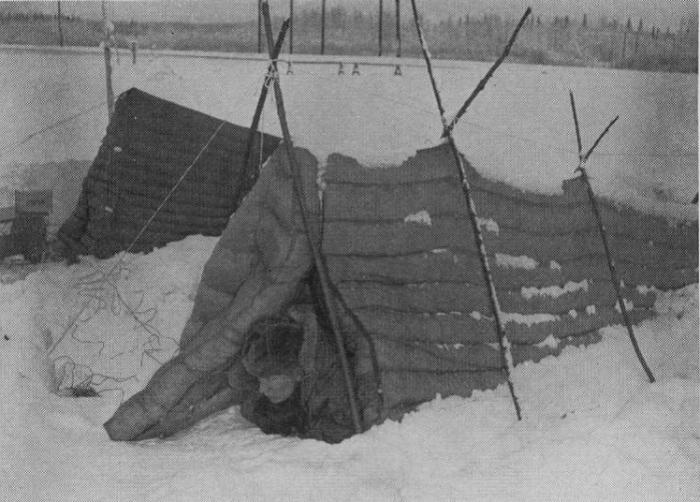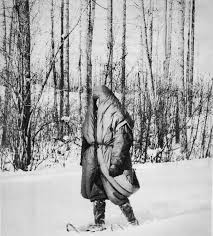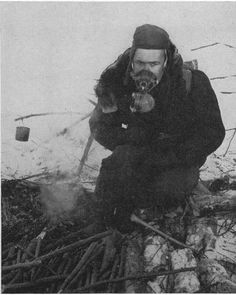In 1947, the United States Air Force (USAF) created the fascinating, and sometimes controversial, Arctic Aeromedical Laboratory (AAL) based out of the Ladd Air Force Base in Fairbanks, AK. With the close of WWII and rising tensions with Russia, the United States saw the arctic as a potential theater for war, which prompted research that would provide information about human survival and success in the Arctic. The work from this research is still relevant today and summaries can be found through the Cultural Resources Management at Fort Wainwright among other places.
The AAL was almost given free rein and experiments were basically whatever they seemed would be most useful. Some of these included studies on edible plants, the seemingly ridiculous Walk-Around Sleeping Bag, and the infamous thyroid study that gave participants a medical tracer that emitted radiation.
 Testing tents in the cold Arctic weather. Courtesy of Ladd Air Force Base, Alaska, Technical Report 1959
Testing tents in the cold Arctic weather. Courtesy of Ladd Air Force Base, Alaska, Technical Report 1959
 The AAL Walk-Around Sleeping Bag Experiment. Courtesy of Ladd Air Force Base, Alaska, Technical Report 1959
The AAL Walk-Around Sleeping Bag Experiment. Courtesy of Ladd Air Force Base, Alaska, Technical Report 1959
For me, the two most interesting experiments measured the energy expenditure and ration limits for human arctic survival. The first measured energy use in low temperatures with studies showing an increase in metabolism due to weight of clothing and a need to maintain body temperature. This got me thinking about the Arctic Ground Squirrel (Spermophilus parryii), a burrowing rodent found primarily above Southeast Alaska. Unlike humans, this species hibernates in order to save energy in the winter months. Adaptations during this slumber include lowering of their metabolic rate and body temperature, which can get below freezing.
 Testing energy expenditure in humans near the Ladd Air Force Base in Fairbanks, AK. Courtesy of Ladd Air Force Base, Alaska, Technical Report 1959
Testing energy expenditure in humans near the Ladd Air Force Base in Fairbanks, AK. Courtesy of Ladd Air Force Base, Alaska, Technical Report 1959
The AAL ration experiments helped to determine field rations for the US Government. Similar studies have continued over the years. At the Ladd Air Force Base, the first participants in this study ran out of rations in the bush and began to capture and eat, you guessed it, the Arctic Ground Squirrel. Relatively easy to catch during their hibernation period, they were a good source of food in a pinch.
 The Arctic Ground Squirrel in its natural habitat. Courtesy of Alaska Department of Fish and Game
The Arctic Ground Squirrel in its natural habitat. Courtesy of Alaska Department of Fish and Game
The Arctic Ground Squirrel is in the news again as scientists are starting to study the affects of small animals on the release of greenhouse gases from permafrost. Permafrost is the arctic ground that is permanently frozen all year round. This soil stores about 850 gigatons (1 gigaton = one billion tons) of carbon and, if released due to warming, could accelerate climate change at an alarming rate. New studies have shown that the Arctic Ground Squirrel is playing a major role in the release of this carbon. As a burrowing species, they mix soil layers causing exposure of more carbon from the permafrost and they fertilize the area with their waste which increases the temperature of their underground homes. Studies are in their infancy, but scientists believe that the Arctic Ground Squirrel plays a bigger role in carbon release from permafrost than previously thought. Thus, Arctic Ground Squirrels have joined the club of mammals whose way of life now contributes to climate change.
A Question From the Crow's Nest
Arctic Ground Squirrels exhibit sexual dimorphism. What does this mean for the species? Answer in the comments below!
Answer from the previous post: The USCGC Healy is 420' long!


Comments
Add new comment